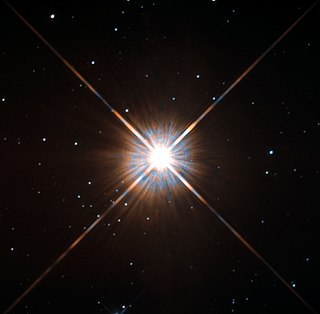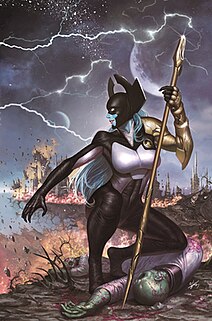
Alpha Centauri is the closest star system and closest planetary system to the Solar System at 4.37 light-years (1.34 pc) from the Sun. It is a triple star system, consisting of three stars: α Centauri A, α Centauri B, and α Centauri C.

Proxima Centauri is a small, low-mass star located 4.244 light-years (1.301 pc) away from the Sun in the southern constellation of Centaurus. Its Latin name means the "nearest [star] of Centaurus". This object was discovered in 1915 by Robert Innes and is the nearest-known star to the Sun. With a quiescent apparent magnitude of 11.13, it is too faint to be seen with the naked eye. Proxima Centauri forms a third member of the Alpha Centauri system, being identified as component Alpha Centauri C, and is 2.18° to the southwest of the Alpha Centauri AB pair. Currently it has a physical separation of about 12,950 AU (1.94 trillion km) from AB and an orbital period of 550,000 years.
"Rautavaara's Case" is a science fiction short story by American writer Philip K. Dick. It was first published in 1980 in Omni magazine and subsequently in the 1985 short story collection I Hope I Shall Arrive Soon. The story was also included on We Can Remember It For You Wholesale, volume five of the Collected Short Stories of Philip K. Dick in 2003.

Próxima Estación: Esperanza is an album by Manu Chao. It was released in Europe in 2001. It was released in the United States on 5 June 2001 on Virgin Records. Chao and others sing in Arabic, English, French, Galician, Portuguese and Spanish on this album. The backing track to "Homens", a tight rap about various kinds of men, written and performed by Brazilian journalist Valeria dos Santos Costa, is identical to the backing track for "Bongo Bong", Chao's successful single from four years earlier; however, in the short documentary film Infinita tristeza, Chao stated that "Homens" was the song for which the well-known backing track was originally recorded. The final song on the album, "Infinita Tristeza", does not contain any vocals by Chao, but it consists of the same backing track as "Me Gustas Tú", over which several samples and soundbites are layered; most of them come from a cartoon-based TV documentary film about pregnancy and childbirth, produced in 1977 by TVE and aimed at children. A number of voice samples from the documentary are looped and repeated throughout the track in Chao's typical fragmented style.

Glenealy is one of the few roads or streets without a suffix in Hong Kong. Located in the Mid-levels on the Hong Kong Island, Hong Kong, it starts from Ice House Street and goes uphill to Hong Kong Zoological and Botanical Gardens, across Robinson Road and ends at Hornsey Road and Conduit Road.

Glenealy is a village 8 km (5.0 mi) west of Wicklow Town, in County Wicklow, on the R752. The Dublin - Rosslare railway line also passes through the village.

The European white egg, Bearded Amanita or European Egg Amidella, is a species of fungus of the genus Amanita in the family Amanitaceae. It is a large, white-colored fungus, often tinged with cream. Native to Europe, it is found on plains as well as mountains in the Mediterranean region. The species was first described in 1833 by Pierre Bulliard, a French physician and botanist, and Lucien Quélet, a French mycologist and naturalist.
Proxima may refer to one of the following:

Glenealy is a Gaelic Athletic Association club located in the parish of Glenealy and Ashford in County Wicklow, Ireland. The club was founded in 1885 as a football club but switched codes to the game of hurling in the early 1920s.
A Próxima Vítima is a Brazilian telenovela that was produced and aired by TV Globo from March 13, 1995, to November 3, 1995, totaling 203 chapters.

Proxima Midnight is a fictional cosmic supervillain appearing in American comic books published by Marvel Comics. She is a prominent member of the Black Order, a team of aliens who work for the titan Thanos.

Corvus Glaive is a fictional supervillain appearing in American comic books published by Marvel Comics. He is a prominent member of the Black Order, a team of aliens who work for Thanos.

Glenea spinifera is a species of longhorn beetles belonging to the family Cerambycidae, subfamily Lamiinae.

Glenea is a genus of longhorn beetles belonging to the family Cerambycidae, subfamily Lamiinae.

The Black Order is a fictional supervillain team appearing in American comic books published by Marvel Comics.
Parit is a federal constituency in Perak, Malaysia, that has been represented in the Dewan Rakyat since 1959.
A Próxima Atração is a Brazilian telenovela produced and broadcast by Rede Globo. It premiered on 26 October 1970 and ended on 17 April 1971, with a total of 150 episodes. It's the seventh "novela das sete" to be aired at the timeslot. It is created by Vicente Sesso and directed by Régis Cardoso.

Proxima Centauri b is an exoplanet orbiting in the habitable zone of the red dwarf star Proxima Centauri, which is the closest star to the Sun and part of a triple star system. It is located about 4.2 light-years from Earth in the constellation of Centaurus, making it the closest known exoplanet to the Solar System.

Amanita proxima is a species of Amanita from France, Italy, and Spain.
Glenea lineata is a species of beetle in the family Cerambycidae. It was described by Charles Joseph Gahan in 1897.













